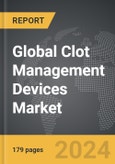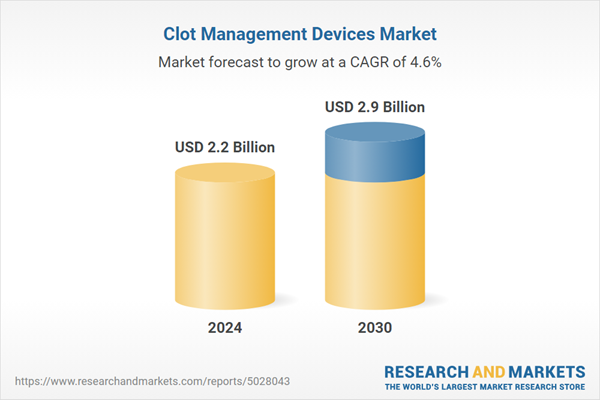The global market for Clot Management Devices was valued at US$2.2 Billion in 2024 and is projected to reach US$2.9 Billion by 2030, growing at a CAGR of 4.6% from 2024 to 2030. This comprehensive report provides an in-depth analysis of market trends, drivers, and forecasts, helping you make informed business decisions. The report includes the most recent global tariff developments and how they impact the Clot Management Devices market.
Segments: Segment (Percutaneous Thrombectomy Devices, Catheter-Directed Thrombolysis (CDT) Devices, Inferior Vena Cava Filters (IVCF), Neurovascular Embolectomy Devices, Embolectomy Balloon Catheters); End-Use (Hospitals, Diagnostic Centers).
Geographic Regions/Countries: World; United States; Canada; Japan; China; Europe (France; Germany; Italy; United Kingdom; and Rest of Europe); Asia-Pacific; Rest of World.
The analysts continuously track trade developments worldwide, drawing insights from leading global economists and over 200 industry and policy institutions, including think tanks, trade organizations, and national economic advisory bodies. This intelligence is integrated into forecasting models to provide timely, data-driven analysis of emerging risks and opportunities.
Global Clot Management Devices Market - Key Trends and Drivers Summarized
Why Are Clot Management Devices Becoming a Critical Tool in Modern Medicine?
Clot management devices have gained significant attention in modern medicine due to the increasing prevalence of conditions like deep vein thrombosis (DVT), pulmonary embolism (PE), and ischemic strokes, which are all caused by the formation of blood clots. These conditions pose serious health risks, including life-threatening complications like heart attacks, strokes, and chronic venous insufficiency. The growing incidence of cardiovascular diseases, an aging population, and lifestyle-related risk factors such as obesity and sedentary behavior have all contributed to a surge in cases requiring intervention for blood clot removal or management. Clot management devices, designed to either dissolve, remove, or prevent blood clots, are seen as critical tools in improving patient outcomes and reducing the risk of long-term complications. With the advent of minimally invasive procedures, these devices have become a preferred treatment option over traditional methods like open surgery or long-term anticoagulant therapy, as they offer quicker recovery times, fewer complications, and more targeted treatment approaches.How Are Technological Advancements Transforming Clot Management Solutions?
The clot management device landscape has evolved rapidly thanks to technological advancements that are making procedures safer, faster, and more effective. One of the most significant developments is in the area of mechanical thrombectomy devices, which are designed to physically remove clots from arteries or veins, typically during minimally invasive catheter-based procedures. These devices have revolutionized the treatment of ischemic strokes by allowing for timely removal of clots, thereby restoring blood flow to the brain and preventing permanent damage. Additionally, catheter-directed thrombolysis, where clot-dissolving agents are delivered directly to the site of the clot, has seen improvements in both precision and safety. Devices such as aspiration catheters, which use suction to remove clots, and rotational thrombectomy systems, which break clots into smaller, more manageable pieces, are increasingly being utilized in clinical practice to treat DVT and PE. Furthermore, the development of bioabsorbable clot retrieval devices and stent retrievers provides a less invasive option with fewer long-term complications. These advancements are not only improving the efficacy of clot management devices but are also opening new avenues for the treatment of complex and high-risk patients, expanding the use of these technologies in broader medical settings.Where Are Clot Management Devices Making the Greatest Impact?
Clot management devices have proven to be life-saving in a variety of medical fields, particularly in cardiology, neurology, and emergency medicine. In cardiology, the use of clot management devices is critical in treating acute coronary syndromes and venous thromboembolism (VTE), which includes both DVT and PE. These devices help to quickly restore blood flow and prevent the progression of clots that can lead to heart attacks or other serious complications. In neurology, mechanical thrombectomy devices are now considered the gold standard for treating ischemic strokes caused by large vessel occlusions. Rapid clot removal within the crucial time window can significantly improve neurological outcomes and reduce the risk of long-term disability. In emergency medicine, clot management devices are used to quickly address life-threatening embolisms or venous blockages, allowing patients to recover more rapidly and reducing the overall strain on intensive care resources. The rising prevalence of clot-related conditions in patients with cancer, long-term immobility, or genetic predispositions has also increased the need for these devices across a broader range of healthcare settings, from intensive care units to outpatient clinics. As medical professionals continue to refine clot management protocols, these devices are making a profound impact on improving survival rates and quality of life for patients with thrombotic diseases.What Factors are Driving the Expansion of the Clot Management Devices Market?
The growth in the clot management devices market is driven by several factors, including the rising incidence of cardiovascular diseases, strokes, and venous thromboembolism. An aging global population is a key contributor, as older individuals are at higher risk for blood clots due to slower circulation, comorbid conditions, and prolonged immobility. Additionally, lifestyle factors such as increasing rates of obesity, sedentary lifestyles, and smoking are further exacerbating the prevalence of conditions that require clot management intervention. The market is also propelled by technological advancements that have made clot removal procedures safer, quicker, and more accessible. Innovations in mechanical thrombectomy devices, such as stent retrievers and aspiration systems, have drastically improved patient outcomes, particularly in stroke management. The growing adoption of minimally invasive procedures, which offer reduced recovery times and fewer complications compared to traditional surgery, is another major driver of market expansion. Moreover, as healthcare providers focus on reducing hospital stays and improving long-term outcomes, there is increased demand for devices that can provide fast, effective clot resolution. Favorable reimbursement policies, particularly in developed healthcare markets, alongside rising awareness among physicians and patients about the importance of timely clot intervention, are further fueling the market. As the incidence of clot-related conditions continues to rise, the demand for advanced clot management devices is expected to grow significantly, driven by these diverse factors.Report Scope
The report analyzes the Clot Management Devices market, presented in terms of units. The analysis covers the key segments and geographic regions outlined below.Segments: Segment (Percutaneous Thrombectomy Devices, Catheter-Directed Thrombolysis (CDT) Devices, Inferior Vena Cava Filters (IVCF), Neurovascular Embolectomy Devices, Embolectomy Balloon Catheters); End-Use (Hospitals, Diagnostic Centers).
Geographic Regions/Countries: World; United States; Canada; Japan; China; Europe (France; Germany; Italy; United Kingdom; and Rest of Europe); Asia-Pacific; Rest of World.
Key Insights:
- Market Growth: Understand the significant growth trajectory of the Percutaneous Thrombectomy Devices segment, which is expected to reach US$1.1 Billion by 2030 with a CAGR of a 4.9%. The Catheter-Directed Thrombolysis (CDT) Devices segment is also set to grow at 4.1% CAGR over the analysis period.
- Regional Analysis: Gain insights into the U.S. market, valued at $610.7 Million in 2024, and China, forecasted to grow at an impressive 4.4% CAGR to reach $463.4 Million by 2030. Discover growth trends in other key regions, including Japan, Canada, Germany, and the Asia-Pacific.
Why You Should Buy This Report:
- Detailed Market Analysis: Access a thorough analysis of the Global Clot Management Devices Market, covering all major geographic regions and market segments.
- Competitive Insights: Get an overview of the competitive landscape, including the market presence of major players across different geographies.
- Future Trends and Drivers: Understand the key trends and drivers shaping the future of the Global Clot Management Devices Market.
- Actionable Insights: Benefit from actionable insights that can help you identify new revenue opportunities and make strategic business decisions.
Key Questions Answered:
- How is the Global Clot Management Devices Market expected to evolve by 2030?
- What are the main drivers and restraints affecting the market?
- Which market segments will grow the most over the forecast period?
- How will market shares for different regions and segments change by 2030?
- Who are the leading players in the market, and what are their prospects?
Report Features:
- Comprehensive Market Data: Independent analysis of annual sales and market forecasts in US$ Million from 2024 to 2030.
- In-Depth Regional Analysis: Detailed insights into key markets, including the U.S., China, Japan, Canada, Europe, Asia-Pacific, Latin America, Middle East, and Africa.
- Company Profiles: Coverage of players such as Boston Scientific Corporation, Cook Medical LLC, DePuy Synthes, Edwards Lifesciences Corporation, iVascular S.L.U and more.
- Complimentary Updates: Receive free report updates for one year to keep you informed of the latest market developments.
Some of the 11 companies featured in this Clot Management Devices market report include:
- Boston Scientific Corporation
- Cook Medical LLC
- DePuy Synthes
- Edwards Lifesciences Corporation
- iVascular S.L.U
- LeMaitre Vascular, Inc.
- Medtronic PLC
- Straub Medical AG
- Teleflex Inc.
- Vascular Solutions, Inc.
Tariff Impact Analysis: Key Insights for 2025
Global tariff negotiations across 180+ countries are reshaping supply chains, costs, and competitiveness. This report reflects the latest developments as of April 2025 and incorporates forward-looking insights into the market outlook.The analysts continuously track trade developments worldwide, drawing insights from leading global economists and over 200 industry and policy institutions, including think tanks, trade organizations, and national economic advisory bodies. This intelligence is integrated into forecasting models to provide timely, data-driven analysis of emerging risks and opportunities.
What’s Included in This Edition:
- Tariff-adjusted market forecasts by region and segment
- Analysis of cost and supply chain implications by sourcing and trade exposure
- Strategic insights into geographic shifts
Buyers receive a free July 2025 update with:
- Finalized tariff impacts and new trade agreement effects
- Updated projections reflecting global sourcing and cost shifts
- Expanded country-specific coverage across the industry
Table of Contents
I. METHODOLOGYII. EXECUTIVE SUMMARY2. FOCUS ON SELECT PLAYERSIII. MARKET ANALYSISIV. COMPETITION
1. MARKET OVERVIEW
3. MARKET TRENDS & DRIVERS
4. GLOBAL MARKET PERSPECTIVE
UNITED STATES
CANADA
JAPAN
CHINA
EUROPE
FRANCE
GERMANY
ITALY
UNITED KINGDOM
REST OF EUROPE
ASIA-PACIFIC
REST OF WORLD
Companies Mentioned (Partial List)
A selection of companies mentioned in this report includes, but is not limited to:
- Boston Scientific Corporation
- Cook Medical LLC
- DePuy Synthes
- Edwards Lifesciences Corporation
- iVascular S.L.U
- LeMaitre Vascular, Inc.
- Medtronic PLC
- Straub Medical AG
- Teleflex Inc.
- Vascular Solutions, Inc.
Table Information
| Report Attribute | Details |
|---|---|
| No. of Pages | 179 |
| Published | April 2025 |
| Forecast Period | 2024 - 2030 |
| Estimated Market Value ( USD | $ 2.2 Billion |
| Forecasted Market Value ( USD | $ 2.9 Billion |
| Compound Annual Growth Rate | 4.6% |
| Regions Covered | Global |









